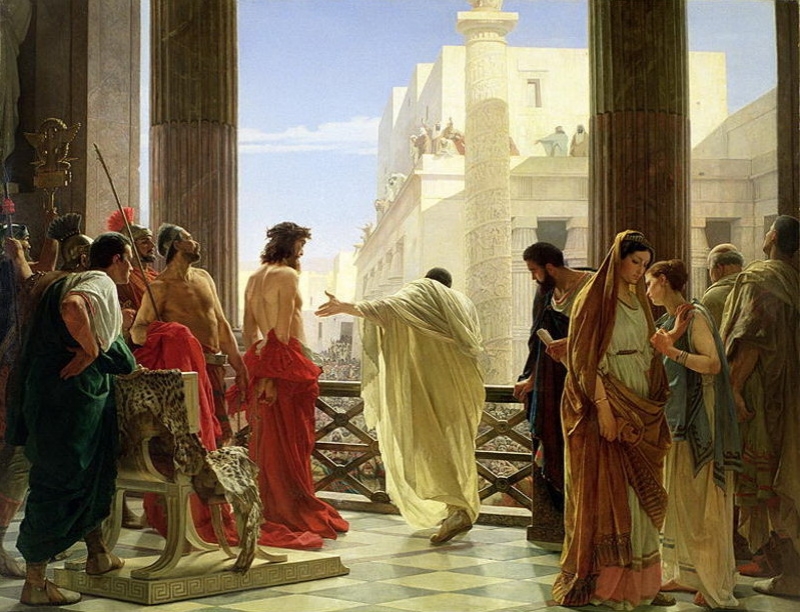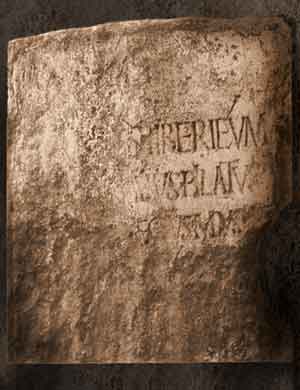
The historical existence of Pontius Pilate was doubted by many scholars up until the summer of 1961 when a limestone block 82 centimetres high 65 centimeres wide, was discovered in secondary use on the western steps of the Roman theatre in Caesarea, Israel. The lime block (approximate age: 26-37 after Yeshua) is a fragment of the dedicatory inscription of a building, probably a temple, that was constructed, possibly in honour of the emperor Tiberius.
The stone was then reused in the 4th century as a building block for a set of stairs belonging to a structure erected behind the stage house of the Herodian theatre, and it was discovered there, still attached to the ancient staircase, by the archaeologists.
Material: Limestone
Height: 82 centimetres
Width: 65 centimetres

The inscription (with suggested reconstruction) reads as follows in Latin:
[DIS AUGUSTI]S TIBERIEUM
[. . . . PO]NTIUS PILATUS
[. . .PRAEF]ECTUS IUDA[EA]E
[. .FECIT D]E[DICAVIT]
Translation by K. C. Hanson & Douglas E. Oakman
To the honorable gods (this) Tiberium
Pontius Pilate,
Prefect of Judea,
had dedicated
PILATE IN EXTRA-BIBLICAL WRITINGS
Philo of Alexandria , a Jewish philosopher (c. 20 {before Yeshua} – c. 50 {after Yeshua} mentions Pilate in The Embassy to Caligula – ca. 40 {after Yeshua}
Pilate was an official who had been appointed prefect of Judaea. With the intention of annoying the Jews rather than of honouring Tiberius, he set up gilded shields in Herod’s palace in the Holy City…
Josephus Flavius (37 – 100 {after Yeshua}), a Jewish historian wrote about Pilate
About this time there lived Jesus, a wise man, if indeed one ought to call him a man. For he was one who performed surprising deeds and was a teacher of such people as accept the truth gladly. He won over many Jews and many of the Greeks. He was the Messiah. And when, upon the accusation of the principal men among us, Pilate had condemned him to a cross, those who had first come to love him did not cease. He appeared to them spending a third day restored to life, for the prophets of God had foretold these things and a thousand other marvels about him. And the tribe of the Christians, so called after him, has still to this day not disappeared.
Jewish Antiquities, 18.3.3 §63 (Based on the translation of Louis H. Feldman, The Loeb Classical Library).
Tacitus (senator and historian of the Roman Empire – ca. 56-120 {after Yeshua}) reports,
Christus, from whom the name had its origin [Christianity], suffered the extreme penalty during the reign of Tiberius at the hands of one of our procurators, Pontius Pilatus…
GOVERNOR, PREFECT OR PROCURATOR
In Matthew 27 Pilate is described as being a governor
Matthew 27:2
2 And having bound Him, they led Him away and delivered Him to Pontius Pilate the governor.
The title of “Prefect of Judea” is given to him in the Pilate Inscription.
Additionally, Tacitus refers to him as a “Procurator”
Which one is correct? All three of them are right.
“Prefects” were governors in charge of parts of larger provinces. So Scripture and Archaeology agree. However, Tacitus is not wrong in calling him a procurator because the title of the Roman governors changed from “prefect” to “procurator” during the rule of emperor Claudius (who governed from 41 to 54 after Yeshua)
Sources: K. C Hanson – www.kchanson.com, Ray Downing, Biblical Reproductions, Wikipedia, livius.org – Articles on Ancient History